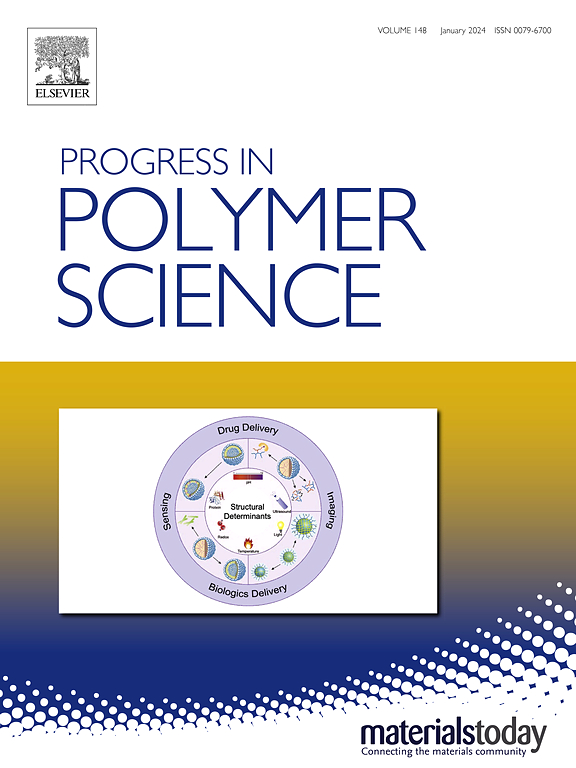高温静电储能电容器用全有机聚合物电介质的最新发展趋势
IF 26.1
1区 化学
Q1 POLYMER SCIENCE
引用次数: 0
摘要
静电储能(EES)电容器对于可再生能源和大功率系统至关重要,它推动了对介电材料的研究,这些材料结合了卓越的电绝缘、机械灵活性、低密度、成本效益和可加工性。聚合物基电介质已成为主要的候选材料,特别是在高电场应用中。然而,传统聚合物在高温环境下,由于电导率的增加和放电能量密度的降低,往往不能满足高温环境的要求,导致能量损失和性能下降。高玻璃化转变温度(Tg)聚合物很有前景,但需要进一步优化,以增强其在热和电应力下的储能能力。本文综述了用于EES电容器的高tg聚合物基介电材料的最新进展,重点介绍了本征聚合物和全有机复合材料。它概述了关键的设计原则,关键性能参数和创新策略-如纳米填料掺杂,分层结构,物理混合和化学交联-以改善电学,热学和机械性能。该综述还强调了新兴趋势,包括整合机器学习算法来探索新型聚合物结构和扩大化学设计空间。通过弥合学术研究与工业应用之间的差距,本文旨在加速能够平衡高温EES电容器多种性能指标的下一代介电材料的开发。本文章由计算机程序翻译,如有差异,请以英文原文为准。


Recent trends in all-organic polymer dielectrics for high-temperature electrostatic energy storage capacitors
Electrostatic energy storage (EES) capacitors are critical for renewable energy and high-power systems, driving the search for dielectric materials that combine superior electrical insulation, mechanical flexibility, low density, cost-effectiveness, and processability. Polymer-based dielectrics have emerged as leading candidates, particularly for high electric field applications. However, conventional polymers often fail to meet the demands of high-temperature environments due to increased electrical conductivity and reduced discharged energy density at elevated temperatures, resulting in energy loss and reduced performance. High glass transition temperature (Tg) polymers show promise but require further optimization to enhance their energy storage capabilities under thermal and electrical stress. This review provides a comprehensive update on recent advancements in high-Tg polymer-based dielectrics for EES capacitors, focusing on both intrinsic polymers and all-organic composites. It outlines key design principles, critical performance parameters, and innovative strategies—such as nanofiller doping, layered architectures, physical blending, and chemical crosslinking—to improve electrical, thermal, and mechanical properties. The review also highlights emerging trends, including the integration of machine learning algorithms to explore novel polymer structures and expand the chemical design space. By bridging the gap between academic research and industrial application, this review aims to accelerate the development of next-generation dielectric materials capable of balancing multiple performance metrics for high-temperature EES capacitors.
求助全文
通过发布文献求助,成功后即可免费获取论文全文。
去求助
来源期刊

Progress in Polymer Science
化学-高分子科学
CiteScore
48.70
自引率
1.10%
发文量
54
审稿时长
38 days
期刊介绍:
Progress in Polymer Science is a journal that publishes state-of-the-art overview articles in the field of polymer science and engineering. These articles are written by internationally recognized authorities in the discipline, making it a valuable resource for staying up-to-date with the latest developments in this rapidly growing field.
The journal serves as a link between original articles, innovations published in patents, and the most current knowledge of technology. It covers a wide range of topics within the traditional fields of polymer science, including chemistry, physics, and engineering involving polymers. Additionally, it explores interdisciplinary developing fields such as functional and specialty polymers, biomaterials, polymers in drug delivery, polymers in electronic applications, composites, conducting polymers, liquid crystalline materials, and the interphases between polymers and ceramics. The journal also highlights new fabrication techniques that are making significant contributions to the field.
The subject areas covered by Progress in Polymer Science include biomaterials, materials chemistry, organic chemistry, polymers and plastics, surfaces, coatings and films, and nanotechnology. The journal is indexed and abstracted in various databases, including Materials Science Citation Index, Chemical Abstracts, Engineering Index, Current Contents, FIZ Karlsruhe, Scopus, and INSPEC.
 求助内容:
求助内容: 应助结果提醒方式:
应助结果提醒方式:


